Premature ejaculation (PE), also known as early ejaculation, rapid ejaculation, or fast climax, is one of the most common sexual dysfunctions in men. It occurs when ejaculation happens sooner than desired, often within a minute of penetration, though some cases involve climaxing within 15 seconds. The issue goes beyond timing, as it leads to frustration, stress, and relationship difficulties. PE has both biological and psychological causes, including low serotonin levels, hormonal imbalances, erectile dysfunction, and prostate infections. Psychological factors such as anxiety, depression, guilt, and performance pressure also contribute to the condition.
Exercise plays a significant role in improving ejaculation control. Strengthening the muscles involved in sexual function enhances endurance, while increased blood circulation supports better erections. Kegel exercises focus on the pelvic floor muscles, particularly the ischiocavernosus and bulbocavernosus, which help control erection and ejaculation. Yoga improves relaxation, flexibility, and muscle control, reducing tension that contributes to early climax. Physical activities like running, swimming, HIIT, and resistance training boost cardiovascular health, improve testosterone levels and enhance overall stamina. While the penis itself lacks muscles, pelvic floor exercises create a stronger support system, improving erection hardness and control. Regular exercise, combined with mental conditioning and lifestyle improvements, provides an effective approach to managing PE and enhancing sexual performance.
- Kegel Exercises
Kegel exercises are the exercises that strengthen the pelvic floor muscles. These muscles play a major role in ejaculation control and erectile function. Kegels improve urinary continence, fecal continence, and ejaculation control. Strong pelvic floor muscles provide better support to the bladder, rectum, and reproductive organs. Improved muscle strength allows men to delay ejaculation and maintain better sexual function.

Research highlights the effectiveness of pelvic floor training for premature ejaculation. A study entitled “The potential role of physical activity in the management of male sexual dysfunction” mentions that 55% to 83% of men experience noticeable improvement after consistent practice. Increased muscle endurance makes it easier to delay ejaculation and maintain erection quality. Strengthening these muscles offers a natural and long-term solution for men struggling with sexual performance issues.
What Are the Pelvic Floor Muscles and Their Role in Sexual Function?
The pelvic floor muscles form a supportive structure beneath the bladder, rectum, and reproductive organs. These muscles extend from the pubic bone to the tailbone, controlling various functions, including urination, defecation, erection, and ejaculation. Key muscles involved in sexual function include:

- Ischiocavernosus muscle – Helps maintain an erection by compressing veins and trapping blood inside the penis.
- Bulbospongiosus muscle – Controls ejaculation by contracting during orgasm and pushing semen through the urethra.
- External anal sphincter – Provides support for bowel movements and adds stability to the pelvic floor.
- Striated urethral sphincter – Assists in urine control and helps with bladder function.
These muscles contract and relax during sexual activity. A strong pelvic floor enhances ejaculation control, erection quality, and overall sexual endurance.
How To Do Kegel Exercises For Men
The pelvic floor muscles can be identified by stopping the flow of urine midstream. The muscles used to pause urination are the ones that need to be strengthened through Kegel exercises. These muscles also tighten naturally during ejaculation and erection.
Another method involves contracting the muscles used to prevent passing gas. This action activates the pelvic floor without engaging the abdomen, thighs, or glutes. Identifying the correct muscles ensures maximum benefits from Kegel exercises.
How to Perform Kegel Exercises Step by Step
- Activating the Pelvic Floor Muscles
The first step involves isolating and activating the correct muscles. Contract the pelvic floor muscles, hold for three seconds, and then relax for three seconds. Repeating this cycle trains the muscles for better endurance.
- Sitting Pelvic Floor Activation
Sitting in a comfortable position allows for better muscle engagement. Keeping the abdomen, thighs, and glutes relaxed, contract the pelvic floor muscles. Holding the contraction for a few seconds increases muscle strength and control.
- Standing Pelvic Floor Activation
Standing positions increase resistance, making the muscles work harder. Engaging the pelvic floor muscles while maintaining good posture enhances ejaculation control and erection quality. Performing Kegels in different positions ensures better results.

What Are the Best Pelvic Floor Exercises for Ejaculation Control?
Strengthening the pelvic floor muscles requires targeted exercises that enhance endurance and control. Three highly effective variations include:
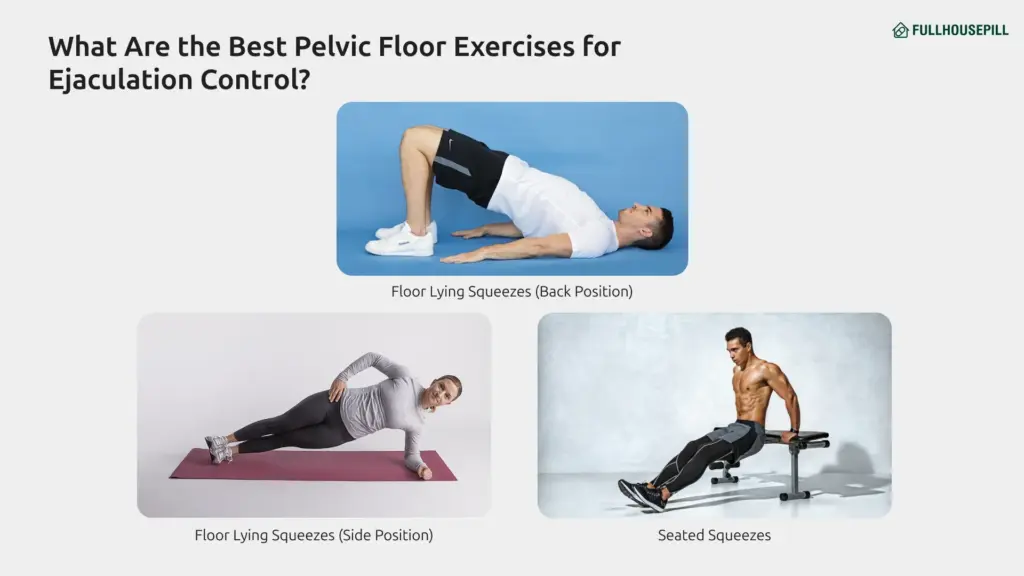
- Floor Lying Squeezes (Back Position)
Lie flat on your back with knees bent and feet resting on the floor. Keep your hands relaxed at your sides. Contract the pelvic floor muscles by pulling your penis inward, as if trying to stop urine flow. Hold for five seconds, then release. Next, tighten the muscles around your anus as if preventing a bowel movement. Hold for five seconds before relaxing. Repeat both movements 8–10 times, completing three to five sets.
- Floor Lying Squeezes (Side Position)
Lie on one side and place a pillow between your knees to keep your legs slightly apart. Squeeze your thighs together, engaging your inner thighs and pelvic floor muscles. Hold for five seconds before relaxing. Repeat 8–10 times, completing three to five sets.
- Seated Squeezes
Sit comfortably in a chair with your feet flat on the floor. Activate the pelvic floor muscles by contracting them as if stopping urine midstream. Hold the contraction for five seconds before releasing. Perform 8–10 repetitions, completing three to five sets. To ensure proper muscle engagement, try stopping urine flow momentarily—if successful, you’re targeting the right muscles.
Consistently practicing these exercises strengthens the pelvic floor, improving ejaculation control, erection quality, and overall sexual endurance.
Does Pelvic Exercises Help Premature Ejaculation?
Kegel exercises offer a proven method for controlling premature ejaculation. Strengthening the bulbospongiosus muscle allows men to resist involuntary contractions that cause early ejaculation. Improved muscle endurance leads to longer-lasting intercourse and better control over orgasm timing. A study by Pastore et al. indicates that consistent pelvic floor training improves ejaculation control within 12 weeks. Men who practice Kegel exercises daily experience stronger erections, improved stamina, and better sexual confidence.
Reverse Kegel Exercises For Men
Reverse Kegel exercises focus on relaxing the pelvic floor muscles rather than contracting them. Many men experience pelvic tension, which contributes to premature ejaculation. Learning to relax these muscles reduces sensitivity and increases ejaculation control.
How to Perform Reverse Kegel Exercises?
Reverse Kegels involve deep breathing and gentle muscle stretching. Sitting in a comfortable position, inhale deeply while expanding the pelvic floor muscles. Exhaling slowly helps relax the muscles. Repeating this process reduces tension and enhances sexual endurance. Combining regular Kegel exercises with Reverse Kegels provides the best results. Strengthening and relaxing the pelvic floor muscles create better control over ejaculation and erections.
2. Yoga For Premature Ejaculation
Yoga improves body awareness, stress control, and flexibility. Many men struggle with premature ejaculation due to anxiety, pelvic tension, and lack of muscle control. Practicing yoga for premature ejaculation helps by reducing stress, improving blood circulation, and enhancing control over the pelvic floor muscles.
A review article published in “The World Journal of Men’s Health” suggests that yoga may be more effective than medication for some men. Regular practice of yoga postures strengthens the muscles involved in ejaculation control, increases stamina, and promotes relaxation. Improved mental and physical balance allows for better control over ejaculation timing.
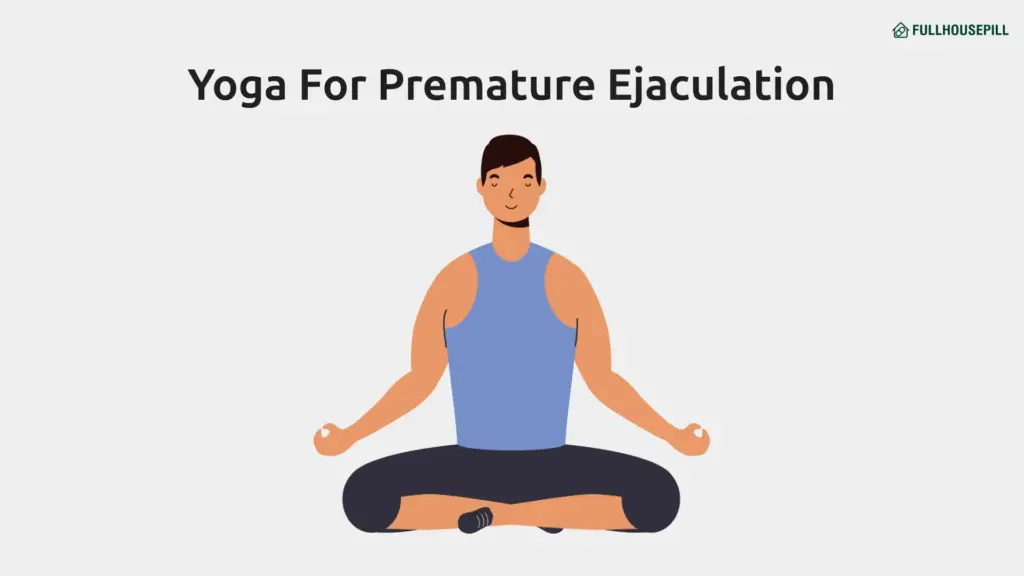
What Yoga Asanas Help With Premature Ejaculation?
Yoga offers a natural way to improve ejaculatory control by strengthening the pelvic muscles, increasing circulation, and promoting relaxation. Various postures focus on different aspects of sexual function, from enhancing endurance to reducing anxiety. Regular practice of these asanas can lead to improved control and overall sexual well-being.
Standing Postures
- Eagle Pose (Garudasana): Engages the pelvic muscles and improves flexibility, helping with ejaculation control.
- Triangle Pose (Trikonasana): Boosts blood circulation to the pelvic area, enhancing sensitivity regulation.
- Standing Forward Bend (Uttanasana): Increases awareness of the pelvic region, supporting better control over ejaculation.
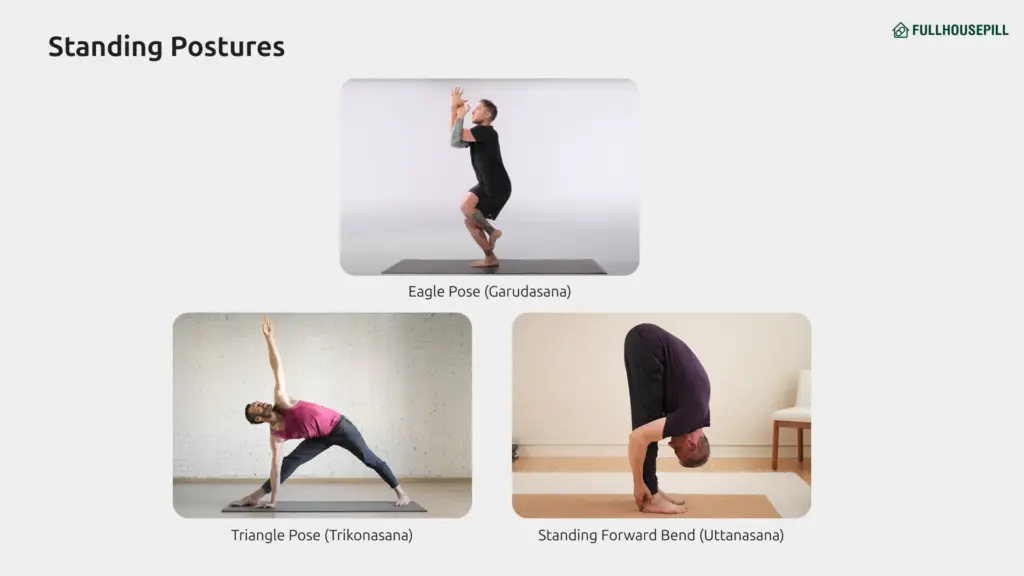
Seated Postures
- Bound Angle Pose (Baddha Konasana): Stimulates circulation in the reproductive system, strengthening sexual stamina.
- Seated Spinal Twist (Ardha Matsyendrasana): Supports nervous system regulation, reducing stress-related PE.
- Seated Forward Bend (Paschimottanasana): Improves overall reproductive health and reduces performance anxiety.
- Head-to-Knee Pose (Janu Sirsasana): Increases flexibility and promotes controlled arousal.
- Wide-Legged Forward Bend (Upavistha Konasana): Helps achieve better orgasm regulation.
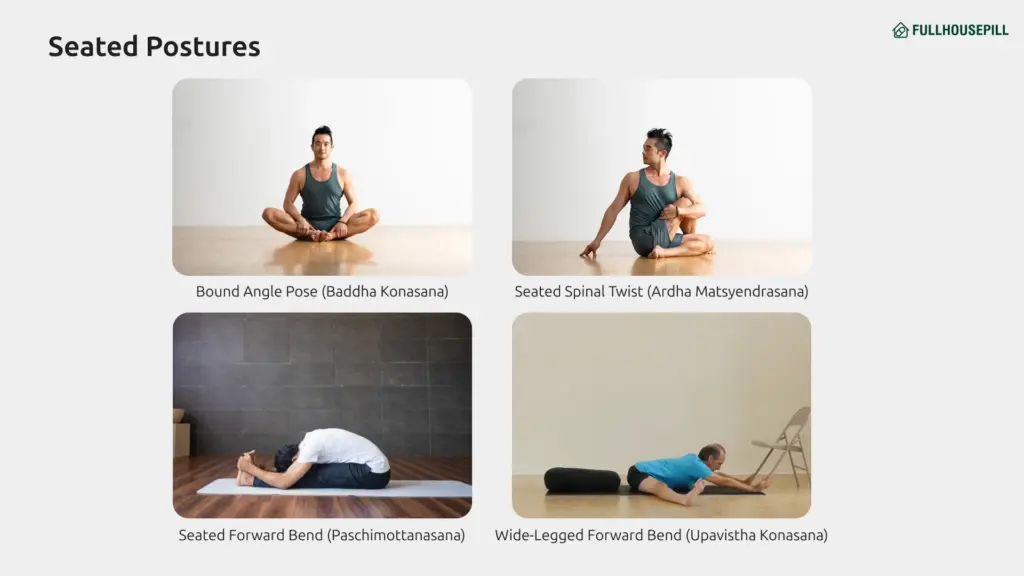
Prone Postures
- Cobra Pose (Bhujangasana): Strengthens pelvic muscles and enhances sexual vitality.
- Bow Pose (Dhanurasana): Stimulates sexual energy while toning reproductive organs.
- Lizard Pose (Utthan Pristhasana): Aids in building endurance and achieving stronger orgasms.
Supine Postures
- Bridge Pose (Setu Bandhasana): Activates the pelvic floor, supporting ejaculation control and endurance.
- Sleeping Thunderbolt Pose (Supta Vajrasana): Strengthens the perineal muscles, helping prevent early ejaculation.
Inversions for Circulation
- Legs-Up-the-Wall Pose (Viparita Karani): Enhances blood flow to the pelvic organs, supporting function and control.
- Shoulder Stand (Sarvangasana): Helps balance hormones and delay ejaculation.
- Plough Pose (Halasana): Strengthens the muscles responsible for ejaculation control.
- Downward Dog (Adho Mukha Svanasana): Encourages healthy circulation and prevents excessive tension in the pelvic area.
Relaxation & Breathing Techniques
- Corpse Pose (Shavasana): Promotes deep relaxation, reducing anxiety linked to performance issues.
- Slow Bhastrika Pranayama: Stabilizes blood pressure and calms the nervous system.
- Alternate Nostril Breathing (Anulom-Vilom): Regulates the autonomic nervous system, aiding in ejaculation timing.
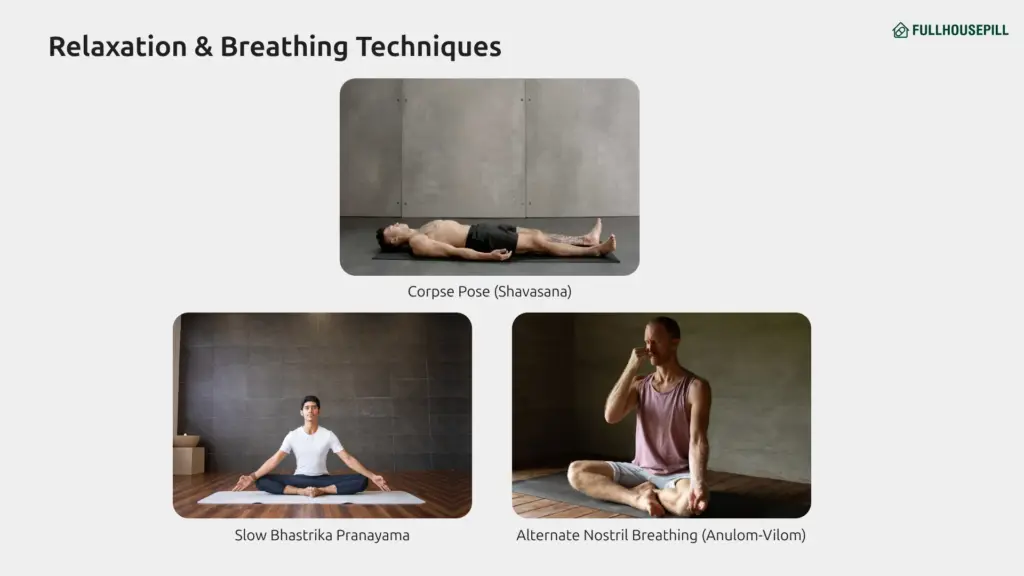
Mudras & Bandhas for Control
- Horse Gesture (Ashwini Mudra): Strengthens perineal muscles, improving ejaculation control.
- Root Lock (Moola Bandha): Enhances awareness of arousal, aiding in better control.
- Vajroli Mudra: Boosts pelvic strength, improving both erection quality and ejaculation timing.
Mindfulness & Meditation
- Yogic Sleep (Yoga Nidra): Lowers stress, increases self-awareness, and improves sexual control.
Each of these practices contributes to a stronger pelvic region, better circulation, and improved mind-body connection. When practiced consistently, yoga can significantly reduce premature ejaculation by promoting endurance, relaxation, and control.
Physical Exercises
High-intensity interval training (HIIT) and aerobic exercises improve cardiovascular health, blood circulation, and endurance. Better blood flow to the genitals enhances erection quality, which plays a vital role in ejaculatory control. Stronger pelvic muscles, improved stamina, and reduced stress contribute to better sexual performance.
A journal article published in Oxford Academic’s Sexual Medicine Reviews shows that men who engage in regular exercise experience fewer sexual dysfunctions, including premature ejaculation. Physical activity boosts testosterone levels, improves nerve function, and promotes overall sexual health. Regular exercise also helps manage anxiety, which is one of the primary causes of premature ejaculation.
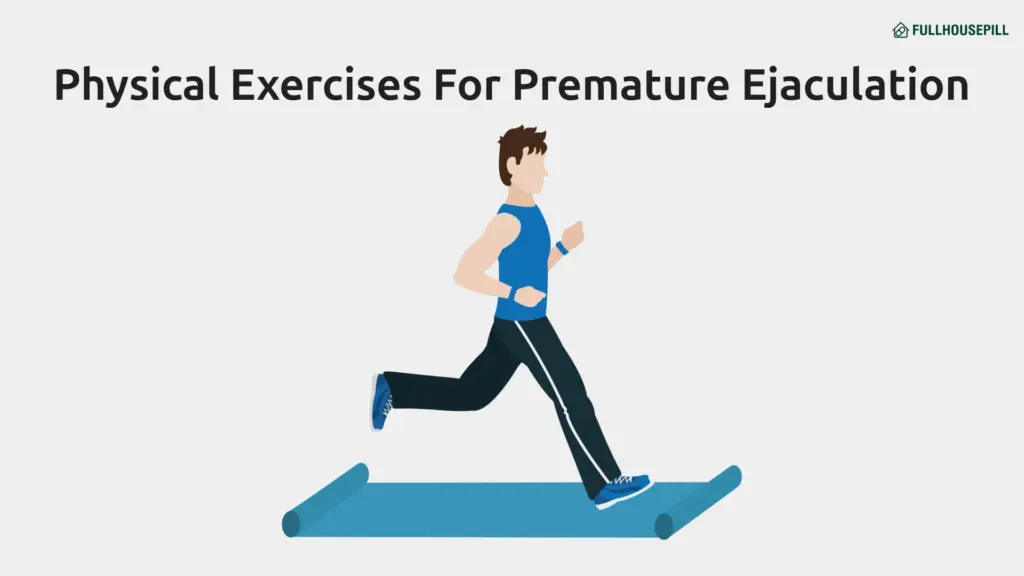
What Are HIIT Exercises and How Do They Help?
HIIT involves short bursts of intense activity followed by brief rest periods. These workouts improve cardiovascular fitness, muscle strength, and endurance. Increased oxygen supply to the muscles enhances overall stamina, helping men last longer during intercourse. HIIT exercises also reduce stress hormone levels, which prevents premature ejaculation triggered by anxiety.
How to Perform HIIT for Better Ejaculatory Control?
- Sprint for 30 seconds, then walk for 1 minute.
- Perform burpees for 30 seconds, followed by a 15-second rest.
- Jump rope for 40 seconds, then rest for 20 seconds.
- Repeat the cycle for 10–15 minutes daily for better sexual endurance.
What Are Aerobic Exercises and How Do They Help?
Aerobic exercises improve heart health, lung capacity, and overall stamina. Regular aerobic activity increases nitric oxide production, which improves blood flow to the genitals. Better circulation results in stronger erections and greater control over ejaculation. Engaging in aerobic workouts also enhances mood, reducing performance-related anxiety that may contribute to premature ejaculation.

- Running
Running boosts cardiovascular endurance, strengthens the leg and core muscles, and improves blood circulation to the pelvic area. Regular running helps regulate testosterone levels, which plays a crucial role in sexual stamina.
How to Incorporate Running Into a Routine?
- Start with 15–20 minutes of jogging.
- Increase intensity by incorporating short sprints.
- Maintain a steady breathing pattern to improve oxygen supply.
- Run at least 4–5 times a week for better ejaculatory control.
- Swimming
Swimming strengthens the core, pelvic floor muscles, and respiratory system. Improved lung capacity and endurance help men maintain better control over their ejaculation. The low-impact nature of swimming reduces stress while promoting better circulation to the reproductive organs.
How to Use Swimming for Sexual Health?
- Swim for 30–40 minutes at a moderate pace.
- Focus on breath control to improve stamina and relaxation.
- Use different strokes like freestyle and breaststroke to engage multiple muscle groups.
- Swim at least 3–4 times a week for optimal results.
- Cycling
Cycling enhances cardiovascular endurance, strengthens the pelvic muscles, and improves blood circulation to the groin area. Regular cycling also lowers stress and anxiety, which are common triggers of premature ejaculation.
How to Cycle for Better Ejaculatory Control?
- Cycle for 30–45 minutes at a moderate pace.
- Maintain a comfortable saddle position to avoid unnecessary pressure on the perineum.
- Increase intensity gradually to build endurance.
- Cycle 4–5 times a week for consistent improvement.
- Weight Training
Weight training boosts testosterone production, strengthens the pelvic floor muscles, and improves overall stamina. Stronger core and lower body muscles enhance blood flow to the reproductive organs, which improves ejaculatory control.
How to Use Weight Training for Ejaculatory Control?
- Perform squats to strengthen the pelvic floor and core muscles.
- Incorporate deadlifts to improve overall muscle endurance.
- Add leg presses and lunges to enhance lower body strength.
- Train at least 3–4 times a week for better results.
What Are The Other Ways To Treat PE
1. Self-treatment
Some men attempt to distract themselves during sex, withdraw before climax, or wear multiple condoms to reduce sensitivity. These methods provide temporary relief but do not address the root cause of premature ejaculation. Psychological factors, muscle control, and nervous system regulation play a significant role in ejaculation timing. Developing better control through targeted techniques, medication, or lifestyle changes offers a more effective and long-term solution.
2. Behavioural Techniques
Behavioural techniques train the body to delay ejaculation and improve sexual endurance. These methods focus on ejaculatory control through physical and mental conditioning.
- The Stop-Start Technique:
The Stop-Start Technique involves stimulating the penis until the urge to ejaculate is strong, then stopping stimulation and allowing the sensation to subside. Resuming stimulation after the feeling diminishes helps train the body to extend sexual activity without climaxing prematurely. Practicing this method regularly increases endurance and improves ejaculation control over time.
- The Squeeze Technique:
The Squeeze Technique requires applying gentle but firm pressure to the base of the penis just before reaching climax. The pressure reduces sensitivity, slows arousal, and prevents ejaculation. Over time, this technique helps men gain better control and prolong intercourse.
3. Medications
Certain medications help men delay ejaculation and improve sexual performance. These Premature Ejaculation Medications work by modifying neurotransmitter levels, reducing penile sensitivity, or affecting nerve response.
Selective Serotonin Reuptake Inhibitors (SSRIs) are antidepressants that delay ejaculation as a side effect. Doctors prescribe Fluoxetine, Paroxetine, and Sertraline for men struggling with PE. Regular use increases serotonin levels, which helps delay orgasm. Dapoxetine is the only SSRI specifically designed to treat premature ejaculation. This medication is taken 1 to 3 hours before intercourse and helps men extend their ejaculation time significantly. Unlike other SSRIs, Dapoxetine has a shorter half-life and works quickly.
Topical anesthetics like lidocaine and prilocaine sprays or creams reduce penile sensitivity, delaying ejaculation without affecting overall pleasure. Applying these numbing agents 10–15 minutes before intercourse can help men last longer without needing systemic medication. Tramadol, an opioid pain reliever, has an off-label use for delaying ejaculation. This medication affects the central nervous system, increasing the time before climax. Clomipramine, a tricyclic antidepressant, also helps control ejaculation by altering serotonin and norepinephrine levels.
- Diet And Lifestyle Changes
A healthy lifestyle plays a major role in sexual performance and ejaculatory control. Proper nutrition, regular sleep, stress management, and physical fitness contribute to better hormonal balance and nervous system regulation.
What Dietary Changes Improve Ejaculatory Control?
- Zinc-rich foods
Oysters, nuts, and seeds support testosterone production and enhance sexual endurance. - Magnesium sources
Dark leafy greens and bananas improve muscle relaxation and nerve function, reducing overstimulation during intercourse. - Omega-3 fatty acids
Fish and flaxseeds enhance blood circulation, promoting stronger erections and better control. - L-arginine supplements
This amino acid increases nitric oxide levels, improving blood flow to the penis for better stamina.
What Lifestyle Changes Help Prevent Premature Ejaculation?
- Regular exercise
Strengthens the pelvic floor muscles, which helps with ejaculatory control. - Stress reduction techniques
Meditation, deep breathing, and yoga lower anxiety, reducing psychological triggers of PE. - Adequate sleep
Restful sleep supports testosterone levels and nervous system function, preventing sexual dysfunction. - Avoiding alcohol and nicotine
Excessive alcohol or smoking weakens nerve function and reduces ejaculatory control.
- Surgical treatments
Surgical procedures exist for severe cases of premature ejaculation, but these treatments carry risks and lack strong clinical evidence.
- Selective Dorsal Neurectomy (SDN)
Selective Dorsal Neurectomy (SDN) is a surgical procedure that reduces penile sensitivity by cutting select dorsal nerves. This procedure is not widely recommended due to the risk of permanent numbness and sexual dysfunction.
- Glans Penis Augmentation
Glans augmentation involves injecting fillers into the penis head to reduce sensitivity. This method provides temporary results and may require repeat procedures.
- Circumcision
Circumcision does not significantly impact premature ejaculation. Some men report reduced sensitivity, but no conclusive evidence supports circumcision as an effective treatment for PE.
